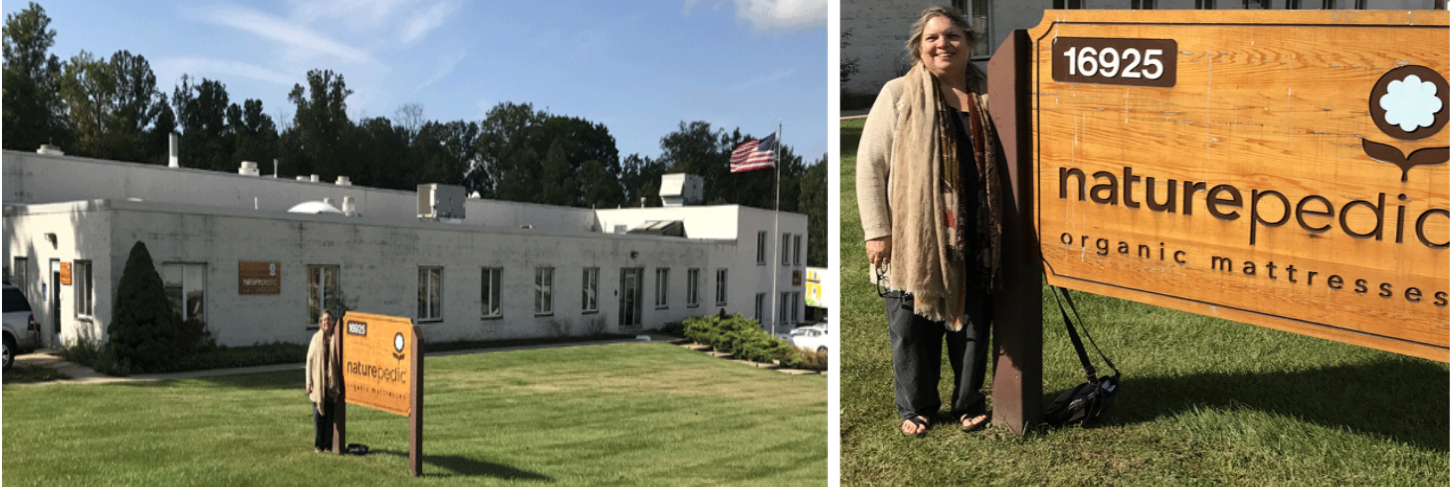
Read my post on the Naturepedic blog Understanding the Global Organic Textile Standard “Organic Mattress” Certification for more information about the GOTS standard and certification.
On 6 September 2017 I visited the Naturepedic mattress factory in Chagrin Falls, Ohio.
This charming village is in the countryside near Cleveland, built in the 1800s around a rushing waterfall in the center of town. The Naturepedic factory is just outside town in a quiet natural setting.
From the beginning, the Naturepedic factory was designed to be free from any toxic chemicals that might find their way into the mattress.
The mattresses are “handmade” in the sense that actual people are making the mattresses and bedding with their own hands. That said, there are also machines that make their work easier, such as sewing machines and heat sealers. There are also machines such as a vacuum machine that pulls all the air out of an innerspring mattress so it can be packed into a smaller box.
The concept of “aseembly line” is well used here, but instead of conveyer belts, products in progress are passed from person-to person, hand-to-hand. Some assembly steps are done by individuals, others by teams of people, such as two workers cutting a large sheet of fabric, their two pairs of scissors meeting in the middle.
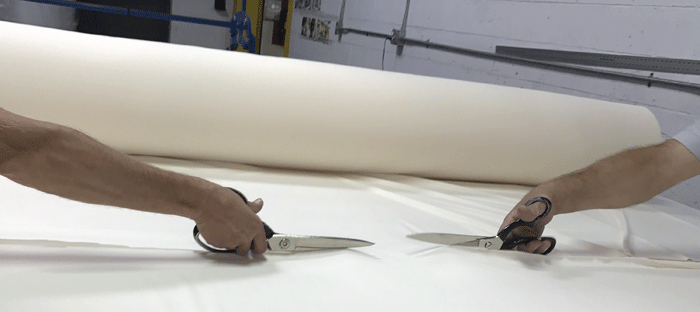
This is typical of the spirit of cooperation that runs throughout the factory.
Many of the workers are local Amish, who begin at 6:30 AM. They asked to start work at this hour because they are already up feeding the animals on their farms at 4 AM and they wanted to get right to work on mattress-making. It made me smile to learn the day before my visit the entire factory closed for the afternoon so everyone could attend the wedding of one of the Amish workers.
As I toured the factory, over and over again I observed excellent relationships between everyone there, at every level. Many of the workers have been with the company for a number of years, some since the beginning. And their experience shines through in the quality of Naturepedic products.
I was introduced to and spoke with many of the workers. I was delighted to hear from many of them how happy they were to work at Naturepedic because they agreed with the basic purpose of the company. One worker told me that he was from a factory town that was full of toxic factories that smelled bad and produced toxic products. He much preferred working at Naturepedic. There just is a lot of love here, and dedication to incorporating their ideals and vision in everything they do.
Being a GOTS Certified Organic Mattress Manufacturer and Facility, Naturepedic must follow strict guidelines:
- All cotton, wool, and other fiber materials must be certified organic.
- Latex must be certified organic (if mattress is also GOLS certified).
- All mattress accessories must be approved by GOTS and must demonstrate that they meet GOTS non-toxic requirements.
- Lot tracking of all materials and components.
Inspectors then come to the factory to ensure the requirements for certification are met.
Inspections include tracking use of materials plus an accounting of all the material entering and leaving the system to ensure the certified materials were used.
Materials are stored in a warehouse next to the workspace where the mattresses and bedding are constructed.
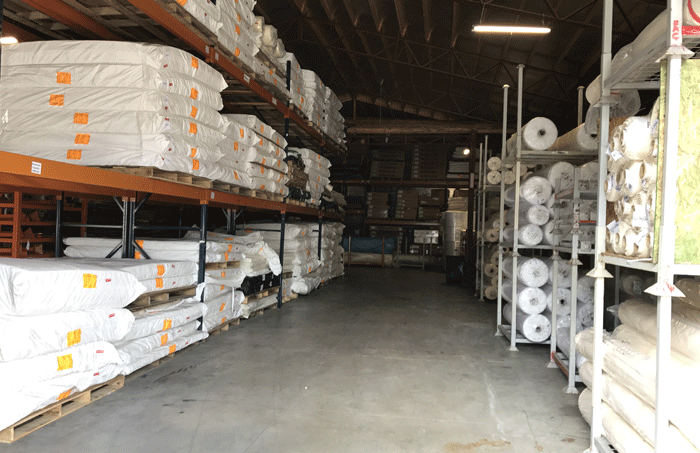
On the early autumn day when I visited, the doors were wide open and a clean breeze was blowing through. All materials are labeled and otherwise tracked for source, date, and anything else required by GOTS.
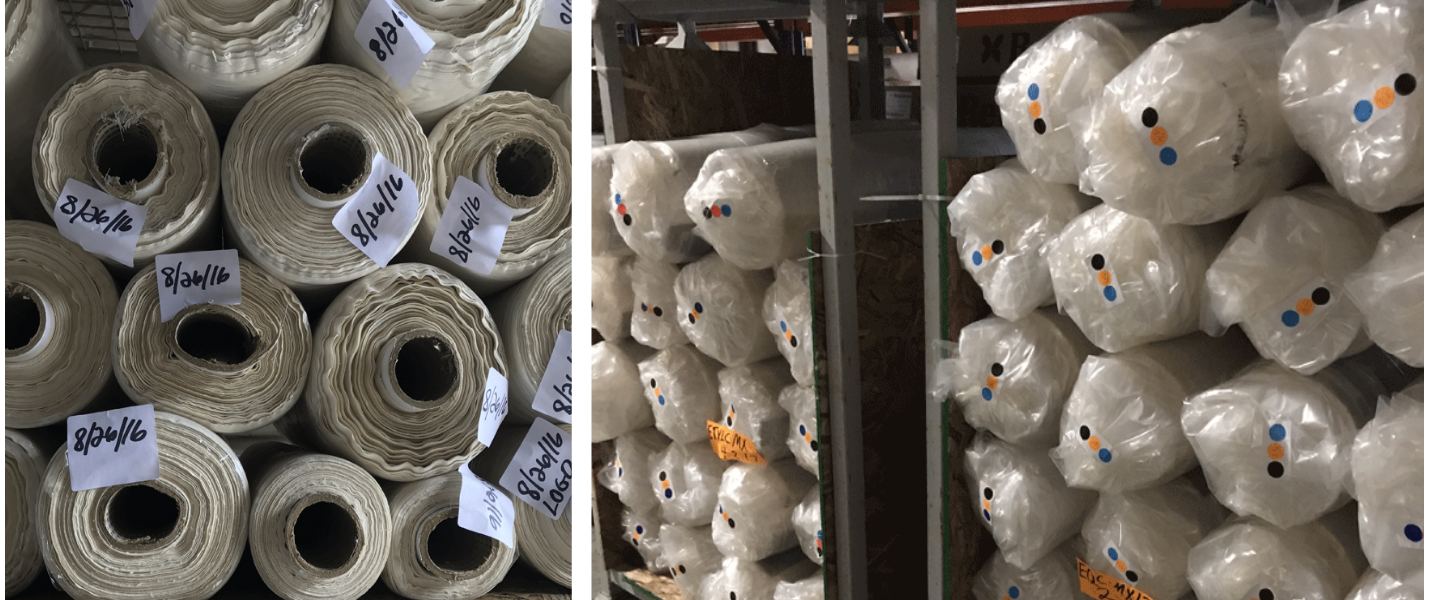
And at the end of the manufacturing process, a label is applied that lists all the materials used that shows the certifications.
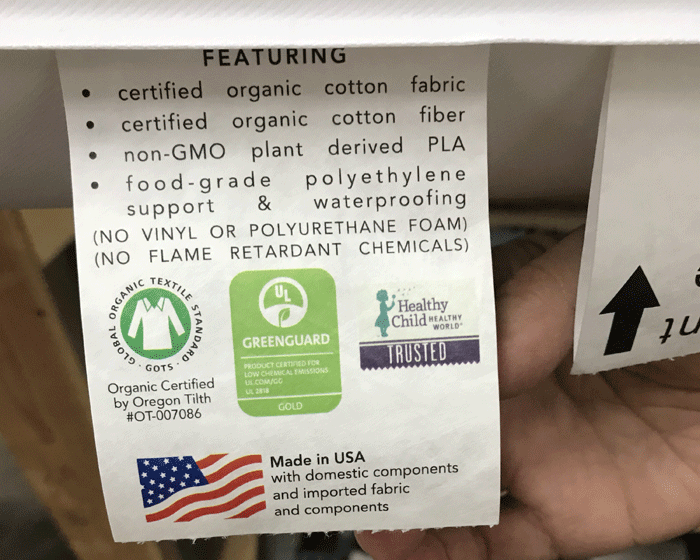
I spent the entire day at the factory and witnessed all the steps of making a mattress from start to finish—from the materials in the warehouse to the boxes being loaded on the shipping truck.
And at the end of the day I wished that every product in the world was manufactured like a Naturepedic mattress.




This spring my husband and I bought our 5 grandchildren, ages 18 months to 9 years old, mattresses and foundations from Naturepedic. Due to the amount of time children spend sleeping on a mattress, we had great concerns for their health because of the toxic chemicals contained in flame retardant materials. Our daughter is a chemist in the food industry, and has made us aware of many sources of toxins. She herself was searching for a non toxic mattress when she discovered Naturepedic. Her and I and her children made the trip to the showroom/factory in Chagrin Falls, Ohio to try out the mattresses. She purchased a queen size for her and her husband. Jesse, who was wonderful at answering all of our questions, and helping us with our choices, is a valuable team member of this business. I am so glad you have brought this business into the spotlight. We look at these mattresses as an investment in our grandchildren’s health. I highly recommend everyone making the investment in their health as well. My husband and I plan to use our next tax return to invest in our health and purchase a set for ourselves.
Debra, with your guidance, my husband and I purchased a Naturepedic EOS (no latex) mattress a few years ago. It was a huge decision for us; I am severely allergic to latex, and because of your help, the Naturepedic folks went above and beyond, to make sure our mattress did not come into contact with any latex. This mattress is a lifesaver for us; SO nice to fall asleep knowing you are not surrounded by toxins. I recommend them (and you) to everyone I know.
Yes, they do go above and beyond to keep the latex separate from other materials so they can make mattresses like yours.
Are there other mattresses for those with MCS who can’t take the “wet hay” smell of organic wool and cotton, and the rubber band smell even of organic latex? What mattress is recommended for me and my many friends like this?
All the nontoxic mattresses I know of are made from natural materials that have their own natural smells.
If you don’t tolerate these natural materials, I would suggest piecing together a mattress for yourself with materials you do tolerate.
Long before these natural mattresses were available, I made my first nontoxic mattress from a metal rollaway bed frame and a pile of washed cotton thermal blankets.
You amy also tolerate a slab of polyuethylene foam, but, while not toxic, it is made from petroleum.
One can objectively make a nontoxic mattress, but it’s very difficult to make a mattress that would be tolerated by each person with their own sensitivities.
What materials would you like a mattress to be made from?
I’m considering Saatva, although it is covered with organic cotton. It’s not compressed into a box and almost all reviews say there is no smell from the mattress.